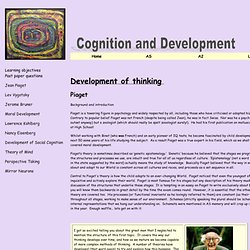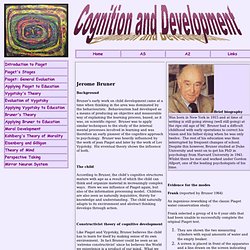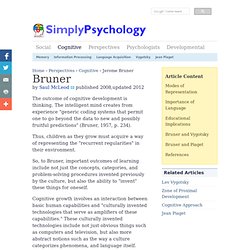

Cognitive Development. Development of thinking Piaget Background and introduction Piaget is a towering figure in psychology and widely respected by all, including those who have criticised or adopted his theories.

Contrary to popular belief Piaget was not French (despite being called Jean), he was in fact Swiss. Nor was he a psychologist (not at the outset anyway) but a zoologist (which should really be spelt zooologist surely!). Whilst working with Binet (who was French) and an early pioneer of IQ tests, he became fascinated by child development and spent the next 50 some years of his life studying the subject. Piaget’s theory is sometimes described as ‘genetic epistemology.’ Central to Piaget's theory is how the child adapts to an ever-changing World.
Schemas and associated concepts Schema: an internal representation of the world. Helen Bee (2000) believes that schemata are not so much the categories themselves but the action of categorising. Disequilibrium is essential for learning!!!! Operations Stages Features: Home. Jerome Bruner Background Bruner’s early work on child development came at a time when thinking in the area was dominated by the behaviourists.

Behaviourism had developed as a means of producing an objective and measurable way of explaining the learning process, based, as it was, on scientific rigour. Bruner was to apply similar techniques to the study of the internal mental processes involved in learning and was therefore an early pioneer of the cognitive approach to psychology. Bruner was heavily influenced by the work of jean Piaget and later by the work of Lev Vygotsky. The child According to Bruner, the child’s cognitive structures mature with age as a result of which the child can think and organize material in increasingly complex ways. Constructivist theory of cognitive development Like Piaget and Vygotsky, Bruner believes the child has to learn for itself by making sense of its own environment. Modes of representation This looks as though its stages but it isn’t! 1. 2. 3. Results. Bruner - Learning Theory in Education. By Saul McLeod published 2008,updated The outcome of cognitive development is thinking.

The intelligent mind creates from experience "generic coding systems that permit one to go beyond the data to new and possibly fruitful predictions" (Bruner, 1957, p. 234). Thus, children as they grow must acquire a way of representing the "recurrent regularities" in their environment. So, to Bruner, important outcomes of learning include not just the concepts, categories, and problem-solving procedures invented previously by the culture, but also the ability to "invent" these things for oneself.
Cognitive growth involves an interaction between basic human capabilities and "culturally invented technologies that serve as amplifiers of these capabilities. " The aim of education should be to create autonomous learners (i.e., learning to learn). Cognitive Theory. By By Saul McLeod 2009, updated 2015 Piaget's (1936) theory of cognitive development explains how a child constructs a mental model of the world.

He disagreed with the idea that intelligence was a fixed trait, and regarded cognitive development as a process which occurs due to biological maturation and interaction with the environment. Piaget was employed at the Binet Institute in the 1920s, where his job was to develop French versions of questions on English intelligence tests. He became intrigued with the reasons children gave for their wrong answers to the questions that required logical thinking.
He believed that these incorrect answers revealed important differences between the thinking of adults and children. Piaget's Stages of Cognitive Development. According to psychologist Jean Piaget, children progress through a series of four critical stages of cognitive development.

Each stage is marked by shifts in how kids understand the world. Piaget believed that children are like "little scientists" and that they actively try to explore and make sense of the world around them. Through his observations of his children, Piaget developed a stage theory of intellectual development that included four distinct stages: The sensorimotor stage, from birth to age 2The preoperational stage, from age 2 to about age 7The concrete operational stage, from age 7 to 11The formal operational stage, which begins in adolescence and spans into adulthood.
Jean Piaget's Background Jean Piaget was born in Switzerland in 1896. Continue reading below our video Loaded: 0% Progress: 0% Simon offered Piaget a position supervising the standardization of the intelligence tests developed by Binet and Simon. What Is a Schema? - Psychology - About.com. Definition: A schema is a cognitive framework or concept that helps organize and interpret information.

Schemas can be useful because they allow us to take shortcuts in interpreting the vast amount of information that is available in our environment. However, these mental frameworks also cause us to exclude pertinent information to instead focus only on things that confirm our pre-existing beliefs and ideas. Schemas can contribute to stereotypes and make it difficult to retain new information that does not conform to our established ideas about the world. The History of Schemas The use of schemas as a basic concept was first used by a British psychologist named Frederic Bartlett as part of his learning theory.
Theorist Jean Piaget introduced the term schema and its use was popularized through his work. Schema Examples For example, a young child may first develop a schema for a horse. Problems With Schemas References: Bartlett, F.C. (1932). Piaget, J. (1928).